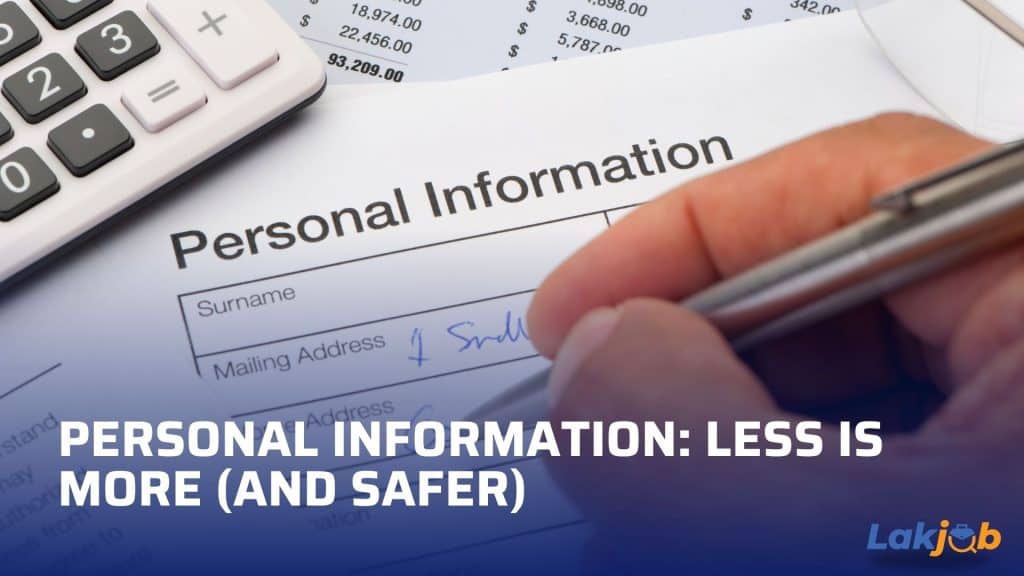Stepping into the U.S. job market as a recent graduate or student is an exciting, yet often challenging, endeavor.
You’ve diligently crafted your resume, focusing on showcasing your skills and potential. But the path to securing that first entry-level job isn’t just about what you should include; it’s equally about understanding what NOT to put on a resume.
A single misstep can inadvertently derail your application, signaling a lack of professionalism, attention to detail, or understanding of industry norms.
This guide will illuminate the common resume pitfalls, especially for new professionals, empowering you to confidently avoid them and present a polished, impactful document that opens doors to exciting opportunities across the United States.
The Golden Rule: Every Element Must Add Value

Think of your resume as prime real estate. Every single word, bullet point, and section must actively contribute to convincing a hiring manager that you are the ideal candidate.
If an element doesn’t enhance your candidacy or is irrelevant, it likely belongs on the “what not to put” list.
For recent graduates, this rule is even more critical, as you’re leveraging every relevant piece of experience and skill you have.
Why Omitting is As Important As Including
- Clarity and Conciseness: Recruiters spend mere seconds reviewing a resume (often less than 7 seconds, according to eye-tracking studies). Clutter obscures key information.
- Professionalism: Irrelevant or inappropriate details can make you appear unprofessional or lacking in judgment.
- ATS Compatibility: Unnecessary formatting or content can confuse Applicant Tracking Systems (ATS), leading to your resume being filtered out before a human even sees it.
- Focus on Relevancy: For entry-level roles, you want to highlight your potential and transferable skills. Anything that detracts from this focus is a disadvantage.
Insight: In a competitive job market, the ability to self-edit and present only the most impactful information demonstrates maturity and strategic thinking qualities highly valued by employers.
Personal Information: Less is More (and Safer)

In the age of digital applications and privacy concerns, the amount of personal information you should include on your resume has significantly narrowed.
The goal is to provide just enough detail for a recruiter to contact you and verify your eligibility to work.
What NOT to Include:
- Full Street Address: Your city and state are sufficient (e.g., “Austin, TX”). Full addresses are unnecessary for initial screening and pose a privacy risk.
- Date of Birth/Age: This is irrelevant to your qualifications and can lead to unconscious bias or discrimination. It’s illegal for employers to discriminate based on age.
- Marital Status/Number of Children: Strictly personal and irrelevant to your professional capabilities. Never include this.
- Religious/Political Affiliation: These are personal beliefs and should not be included on a professional resume.
- Social Security Number (SSN): Never, ever include your SSN on a resume. This is highly sensitive personal information and a major security risk.
- Headshot/Photo: In the U.S., it is standard practice not to include a photo on your resume. This helps prevent bias and ensures a focus on qualifications.
- Gender/Race/Ethnicity: Like age, including this is irrelevant to your qualifications and opens the door to potential bias.
Actionable Tip: Stick to your name, phone number, professional email, LinkedIn URL, and city/state. That’s all a recruiter needs for initial contact.
Irrelevant Content: If It Doesn’t Add Value, It Subtracts

For recent graduates, it’s tempting to fill space, but every piece of “filler” dilutes your most impactful qualifications.
Be ruthless in cutting content that doesn’t serve your core message.
What NOT to Include:
- Objective Statements (Unless Hyper-Specific): Traditional objectives like “Seeking a challenging position where I can utilize my skills” are outdated and focus on you. Instead, use a Resume Summary/Professional Profile that highlights what you offer the employer. If you use an objective, make it a hybrid that combines your goal with your value proposition, tailored to the specific role. For effective examples, explore Resume Objective Examples for First Job.
- “References Available Upon Request”: This is assumed. It wastes valuable space that could be used for more impactful content.
- Hobbies and Interests (Unless Relevant): While personal, these are rarely relevant to a professional role. Only include them if they directly relate to the job’s skills (e.g., “Captain of University Debate Team” for a Communications role, or “Amateur Coder” for a Tech role, if accompanied by projects).
- High School Information (If You Have Higher Education): Once you have an Associate’s Degree or have completed some college, your high school details become less relevant.
- Outdated/Irrelevant Work Experience: For entry-level, if you had a very brief job in middle school that has no transferable skills, omit it. After a few years in the workforce, remove older, non-relevant jobs.
- Excessive Personal Pronouns: Avoid “I,” “me,” “my.” Start bullet points with strong action verbs.
- Repetitive Information: Don’t repeat the same skill or achievement verbatim in multiple places. Vary your wording and focus on different facets of the experience.
- “Responsible for…” or “Duties included…”: These phrases are passive and weak. Instead, use strong action verbs to describe what you achieved and how you contributed.
Insight: Every bullet point should answer the question: “How does this make me a better candidate for this specific job?”
Formatting Faux Pas: The Unseen Rejection

Even if your content is perfect, poor formatting can lead to your resume being overlooked by both machines and humans.
This is especially true for ATS, which can misinterpret complex designs.
What NOT to Include:
- Complex Graphics/Charts/Images: Avoid elaborate infographics, charts, tables, or embedding images (other than a professional headshot, which is typically omitted in the U.S. anyway). These often confuse ATS and can make your resume look unprofessional.
- Fancy Fonts/Too Many Fonts: Stick to clean, professional, and widely readable fonts (e.g., Calibri, Arial, Times New Roman, Georgia). Using more than two fonts can make your resume look messy.
- Excessive Colors: While a subtle use of one accent color can be okay for some creative roles, too many colors or bright, distracting hues look unprofessional. Stick primarily to black text on a white background.
- Unusual Layouts/Text Boxes: Non-standard resume templates with sidebars, multiple columns, or text boxes can often be unreadable by ATS, causing your information to be jumbled or missed entirely.
- Dense Paragraphs: Recruiters scan, they don’t read long paragraphs. Break down information into concise bullet points.
- Too Much Information on One Page: For entry-level roles, a one-page resume is highly preferred. Trying to cram too much information leads to small fonts, tiny margins, and visual clutter.
- Errors in Contact Information: Incorrect phone numbers, email addresses, or non-working LinkedIn URLs are instant disqualifiers.
- Unprofessional Email Address: Ditch the “[email protected]” address. Use a clean, professional email (e.g., “[email protected]”).
Actionable Tip: Prioritize clarity and scannability. If you’re unsure about a design element, err on the side of simplicity. Always save your resume as a PDF to preserve formatting, unless a .docx file is explicitly requested.
Data & Honesty: Integrity is Non-Negotiable

Beyond formatting and content, the integrity of the information you provide is paramount.
Misleading or false statements are ethical violations that can lead to immediate disqualification or even termination if discovered later.
What NOT to Include:
- False Information/Exaggerations: Never lie about dates of employment, job titles, responsibilities, skills, education, or achievements. Even slight exaggerations can backfire.
- Unsubstantiated Claims: Don’t claim “expert” proficiency in a skill if you’re only familiar with it. Be honest about your skill levels.
- Reasons for Leaving Previous Jobs: Your resume is a marketing document, not a confessional. Do not include reasons for leaving past positions. This can be discussed if asked during an interview.
- Salary History/Expectations: Never include past salaries or salary expectations on your resume. This discussion belongs later in the hiring process, typically during the interview stage.
- Negative Information: Avoid any negative comments about past employers, colleagues, or academic experiences. Focus on your positive contributions and what you learned.
- Personal Opinions or Biases: Your resume should be objective and factual, presenting your qualifications without personal commentary or controversial statements.
Insight: Employers value integrity. Building trust begins with an honest and transparent resume. A study by CareerBuilder found that 57% of hiring managers have caught a lie on a resume, with education and embellished skills being the most common falsehoods.
Your “What NOT To Put” Checklist for Entry-Level Resumes
Before you hit “submit,” use this checklist to ensure your resume is free of common pitfalls.
- Personal Information:
- No full street address (City, State is sufficient).
- No date of birth, age, marital status, religion, race, gender.
- No Social Security Number (SSN).
- No personal photo/headshot (in the U.S.).
- Professional email address used.
- Irrelevant Content:
- No generic objective statements (use a tailored summary/hybrid objective).
- No “References Available Upon Request.”
- No irrelevant hobbies/interests.
- No high school info (if you have higher education/certifications).
- No outdated/untransferable work experience (e.g., very brief, unrelated middle school jobs).
- No excessive personal pronouns (“I,” “me”).
- No repetitive information.
- No “Responsible for…” / “Duties included…” phrases.
- Formatting Faux Pas:
- No complex graphics, charts, or images.
- No fancy or more than two professional fonts.
- No excessive or distracting colors.
- No unusual layouts, sidebars, or text boxes that confuse ATS.
- No dense paragraphs (use concise bullet points).
- Resume is one page (for entry-level).
- Contact info is accurate and professional.
- Data & Honesty:
- No false information or exaggerations.
- No unsubstantiated claims (e.g., claiming “Expert” level inaccurately).
- No reasons for leaving previous jobs.
- No salary history or expectations.
- No negative information or personal opinions.
Conclusion: Crafting a Clean, Compelling Narrative
Understanding what NOT to put on a resume is just as crucial as knowing what to include.
For recent graduates, this means strategically eliminating clutter, avoiding outdated practices, ensuring ATS compatibility, and maintaining unwavering honesty.
Your resume is your professional marketing document a concise, tailored argument for why you are the ideal candidate for an entry-level role.
By diligently reviewing your resume against these common pitfalls, you demonstrate attention to detail, professionalism, and a clear understanding of modern hiring practices.
This commitment to a clean, compelling narrative will not only help you bypass automated filters but also make a strong, positive impression on human recruiters.
Polish your resume, remove the unnecessary, and confidently step forward into your job search. Your first great opportunity awaits, and a perfectly clean resume is your key to unlocking it.
F.A.Q
Q1: Should I include personal information like my age, marital status, or nationality on my resume?
A1: No, you should never include personal information such as your age, date of birth, marital status, number of children, nationality, religion, or race on your resume. This information is irrelevant to your qualifications for the job and can open the door to unconscious bias or discrimination. In the U.S., it’s standard practice to omit these details.
Q2: Is it okay to include a photo of myself on my resume?
A2: In the U.S., it is standard practice not to include a photo or headshot on your resume. This helps to prevent bias and ensures that hiring decisions are based solely on your qualifications and skills, not your appearance. Including a photo can inadvertently lead to your resume being overlooked.
Q3: Can I use graphics, charts, or fancy fonts to make my resume stand out?
A3: While visually appealing, complex graphics, charts, images, and excessive fancy fonts are generally not recommended for resumes. They can confuse Applicant Tracking Systems (ATS), leading to your information being parsed incorrectly or missed entirely. Stick to clean, professional, and widely readable fonts (e.g., Calibri, Arial, Times New Roman) and simple layouts to ensure ATS compatibility and clarity for human readers.
I specialize in managing and auditing end-to-end HR functions, ensuring full compliance with state and federal regulations. I partner with leadership to drive strategic HR initiatives and implement necessary changes. My core strength lies in identifying, hiring, and training top talent to enhance team performance and support organizational growth.






